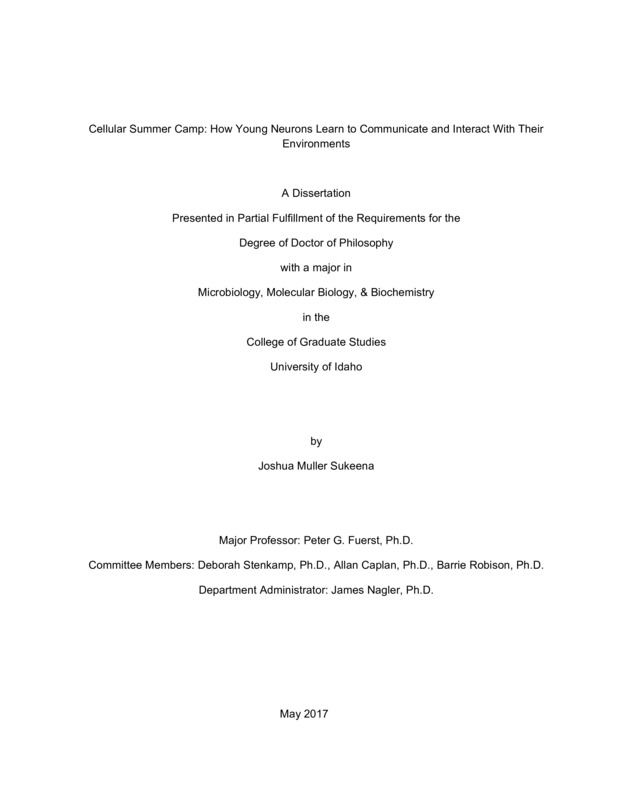Cellular Summer Camp: How Young Neurons Learn to Communicate and Interact With Their Environments
Sukeena, Joshua M.. (2017). Cellular Summer Camp: How Young Neurons Learn to Communicate and Interact With Their Environments. Theses and Dissertations Collection, University of Idaho Library Digital Collections. https://www.lib.uidaho.edu/digital/etd/items/sukeena_idaho_0089e_11093.html
- Title:
- Cellular Summer Camp: How Young Neurons Learn to Communicate and Interact With Their Environments
- Author:
- Sukeena, Joshua M.
- Date:
- 2017
- Embargo Remove Date:
- 2019-06-12
- Keywords:
- bipolar cell adhesion DSCAM evolution retina zebrafish
- Program:
- Biology
- Subject Category:
- Biology; Molecular biology; Biochemistry
- Abstract:
-
The primary sense of humans is vision, and the visual system begins in the retina. The retina is the major light-sensing tissue of the central nervous system that responds to light in the environment and aids in its conversion into visual information. The retina is composed almost entirely of neurons, and is part of the central nervous system proper. It is a major focus of biomedical research due to the debilitating eye diseases that are associated with it. Additionally, its complex circuitry and wiring are ideal for understanding mechanisms and cellular interactions that lead to the development of the nervous system. The work in this dissertation presents multiple novel cellular interactions in the developing nervous system and promotes a possible system for understanding the role that evolution has played in the highly complex teleost retina.
The first chapter gives a brief overview of retina development and why it is a great model system to use in basic science. The second chapter is a review of bipolar cells across species. Here we will review basic development and organization of bipolar cells, followed by physiology and how bipolar cells communicate with cells in the retina. We will also summarize the common model systems used in research today including rodents, teleost fish, and primates. We also use figures to give a thorough and in depth review of their vertical organization and summarize their current classification system.
The third chapter presents a possible compensatory mechanism to preserve cone predictive field in the developing mouse retina following the failure of Bax-mediated programmed cell death. We present a possible feedback mechanism between cone photoreceptors and bipolar cells to ensure tiling organization despite an increase in cellular density. The fourth chapter presents additional roles for an important regulator of neurite targeting, Down syndrome cell adhesion molecular (Dscam). Loss of function assays reveal its role in neurite refinement in the developing mouse retina. We find it necessary for proper refinement and subsequent lamination of type 2 dopaminergic amacrine cells in the inner retina. Gain of function assays with DSCAM also reveal it is not sufficient to drive cell death, increase spatial organization, prevent cell-to-cell pairing, or promote active avoidance in the retina.
The fifth chapter characterizes the expression of DSCAM and SDK in the teleost retina for their potential role in its highly ordered cellular. Adding to that, the full cDNA sequences for DSCAM A and DSCAM B in the zebrafish retina have been cloned for use in cellular interaction assays. Furthermore, the sixth chapter of this work identifies a potential new model system, the spotted gar, for research regarding the evolution of the visual system.
- Description:
- doctoral, Ph.D., Biology -- University of Idaho - College of Graduate Studies, 2017
- Major Professor:
- Fuerst, Peter G
- Committee:
- Stenkamp, Deborah L; Caplan, Allan; Robison, Barrie D
- Defense Date:
- 2017
- Identifier:
- Sukeena_idaho_0089E_11093
- Type:
- Text
- Format Original:
- Format:
- application/pdf
- Rights:
- In Copyright - Educational Use Permitted. For more information, please contact University of Idaho Library Special Collections and Archives Department at libspec@uidaho.edu.
- Standardized Rights:
- http://rightsstatements.org/vocab/InC-EDU/1.0/

